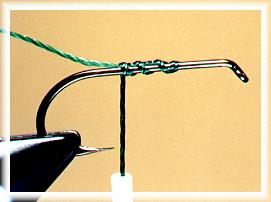Now that I have more time, let me try to clarify:
Regarding dubbing--
The instructions in the prior post would apply to course dubbing such as hares ear. For finer or synthetic, when you pluck it from the dispenser, it will usually come out as a strand-like bunch, rather than a "pinch" as I described. In this instance, you would lay the strand along a section of thread extending perpendicular to the hook shaft (either above or below) and spin it in one direction only, moving your fingers from one end to another, smoothing it fairly evenly over an inch or so of thread up to the hook. Spin it tight and even. It should look like a thicker strand of thread. Then just wind it onto the hook.
Regarding thread starting and a basic procedure for a generic nymph or dry --
Assuming you are right-handed. The hook bend is to the left, the eye to the right; take the end of the thread in between your left index finger and thumb; move the bobbin over top and behind the hook shaft near the eye so the thread from your left hand goes up over the top of the shaft and down the backside to the bobbin; the distance from the end of the string to the hook shaft is about an inch; now bring the bobbin under the hook, winding clockwise (as if you are look down the shaft from eye to bend), holding the thread in your left hand out to the left, so that the clockwise winding traps the thread leading to your left hand against the hook shaft. Once you have taken 5-6 wraps, the thread should be secured and you can cut away the excess or just wrap down toward the bend until the inch of thread is completely covered under. In either case, continue wrapping the thread to the hook bend.
Once you have this thread base, you can wind the thread to the point next needed. I usually tie in the tailing material at this point, a short distance up from the beginning of the bend, then wind back to the bend to secure. Next, for a simple nymph, for instance, if you need a ribbing, tie it in near the tail, then push it back out of the way to the left and dub the thread winding forward to build the abdomen, stopping where the thorax should begin. If using ribbing, wind it up to the same point, then secure it. If the thorax calls for different material, tie it in and then wind forward toward the eye; if you want a wingcase, tie it in before dubbing for the thorax and leave it above and behind as you wind the thorax dubbing forward; tie in your legging or "beard", then pull the wingcase over the thorax and secure and build the head.
For a dry, most times, it is easier to tie in the wing (not the hackle) before building the abdomen. After the tailing is secure, wind forward, tie in the wing, then wind back, dub and wind the abdomen forward to the wing. Then secure the hackle behind the wing, wrap once or twice behind and three or four time in front of the winging, then build the head and whip it.




